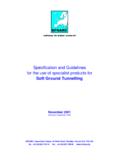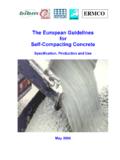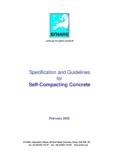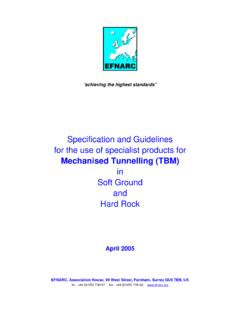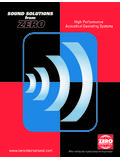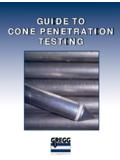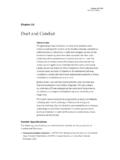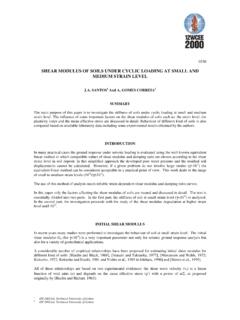Transcription of EFNARC Three Point Bending Test on Square Panel …
1 ENC 371 FTC Experts for Specialised Construction and Concrete Systems TESTING SPRAYED CONCRETE EFNARC Three Point Bending TEST ON Square Panel WITH NOTCH Flexural tensile strength of fibre concrete on sprayed test specimen. June 2011 EFNARC 371 FTC Acknowledgements EFNARC wishes to gratefully acknowledge the work undertaken by the members of its Fibres Technical Committee in the preparation of this document. All comments on this test method should be submitted to the EFNARC secretary: Although care has been taken to ensure, to the best of our knowledge that all data and information contained herein is accurate to the extent that it relates to either matters of fact or accepted practice or matters of opinion at the time of publication, EFNARC assumes no responsibility for any errors in or misrepresentation of such data and/or information or any loss or damage arising from or related to its use.
2 All rights reserved. No part of this publication may be reproduced, stored in a retrieval system or transmitted, in any form or by any means, electronic, mechanical, recording or otherwise, without prior permission of EFNARC . 2011 EFNARCEFNARC Three Point Bending Test on Square Panel with Notch ENC 371 FTC 1 CONTENTS 2 1. 3 2. TERMS AND 3 3. SYMBOLS AND ABBREVIATED 3 4. 4 5. APPARATUS .. 4 6. TEST 6 7. TESTING 6 8. EXPRESSION OF RESULTS .. 9 9. TEST REPORT .. 12 10. PRECISION .. 12 EFNARC Three Point Bending Test on Square Panel with Notch ENC 371 FTC 2 FOREWORD The European standard for sprayed concrete, EN 14487-1, mentions the different ways of specifying the ductility of fibre reinforced sprayed concrete in terms of residual strength and energy absorption capacity. It also mentions that both ways are not exactly comparable and are measured using different test specimen geometries.
3 1) The energy absorption value, measured on Panel specimens, can be prescribed when, as in case of rockbolting, emphasis is placed on energy which has to be absorbed during the deformation of the rock.; especially useful for primary sprayed concrete linings (EN 14488-5:Testing sprayed concrete, part 5: Determination of energy absorption capacity of fibre reinforced slab specimens ). 2) The residual strength value, measured on beam specimens, can be prescribed when the concrete characteristics are used in a structural design model (EN 14488-3:Testing sprayed concrete, part 3: Flexural strengths of fibre reinforced beam specimens) The test method described here for the measurement of residual strength is a Three Point Bending test on Square Panel specimens with notch instead of the EN 14488-3 four Point Bending test on beam specimens.
4 This test method has the following advantages: The geometry is the same as in the Panel test for the measurement of Energy Absorption; The geometry and dimensions of the specimens, as well as the spray method adopted ensure the distribution of the fibres in the matrix are as close as possible to that encountered in the real structure; The dimensions of the test specimen are acceptable for handling within a laboratory (no excessive weights or dimensions); The test is compatible, as far as the experimental means permit, with use in a large number of normal equipped laboratories (no unnecessary sophistication). The Panel can be sprayed on the job site; No requirement to saw prisms from the Panel which can influence the result; The experimental scatter of results should be lower than the current standardised beam test; The notch provides a slower cracking process, thereby reducing the risk of a sudden fall; By analogy to EN 14651, test method for metallic fibre concrete, this test method defines residual flexural strength (fR,1, fR,2, fR,3, fR,4) according to the updated international standard (RILEM - fib Model Code 2010).
5 The obtained mechanical property will serve as input for the dimensioning method. EFNARC Three Point Bending Test on Square Panel with Notch ENC 371 FTC 3 1 SCOPE This proposal specifies a method of measuring the flexural tensile strength of fibre reinforced concrete on sprayed test specimen. The method provides for the determination of the limit of proportionality (LOP) and of a set of residual flexural tensile strength values. The method can be used for metallic fibres, synthetic or other fibres, or a combination of fibre types. 2 TERMS AND DEFINITIONS For the purposes of this Test Method, the following terms and definitions apply. crack mouth opening displacement linear displacement measured by a transducer installed as specified in and illustrated in Figure 3, on a plate subjected to a central line load F. deflection linear displacement measured by a transducer installed as specified in and illustrated in Figure 4, on a plate subjected to a central line load F.
6 Limit of proportionality stress at the tip of the notch which is assumed to act in an uncracked mid-span section, with linear stress distribution, of a plate subjected to the central line load FL, defined in residual flexural tensile strength fictitious stress at the tip of the notch which is assumed to act in an uncracked mid-span section, with linear stress distribution, of a plate subjected to the central line load Fj corresponding to CMODj where CMODj > CMODFL or to j where j > FL (j = 1, 2, 3, 4), defined in 3 SYMBOLS AND ABBREVIATED TERMS Symbols CMODFL CMOD at LOP CMODj value of CMOD, j = 1, 2, 3 or 4 F load Fj load value, j = 1, 2, 3 or 4 FL load at LOP EFNARC Three Point Bending Test on Square Panel with Notch ENC 371 FTC 4 L length of test specimen M Bending moment Mj Bending moment value, j = 1, 2, 3 or 4 ML Bending moment corresponding to the load at LOP b width of test specimen fR,j residual flexural tensile strength, j = 1, 2, 3 or 4 fct,Lf LOP hsp distance between the tip of the notch and the top of the test specimen in the mid-span section l length of span x width of notch y distance between bottom of test specimen and axis of displacement transducer deflection FL deflection at LOP j deflection value, j = 1, 2.
7 3 or 4 Abbreviations CMOD crack mouth opening displacement LOP limit of proportionality 4 PRINCIPLE The tensile behaviour of metallic fibre concrete is evaluated in terms of residual flexural tensile strength values determined from the load-crack mouth opening displacement curve or load-deflection curve obtained by applying Three Point Bending test on a Square plate. 5 APPARATUS Saw with rotating carborundum or diamond blade with adjustable and fixable cutting depth and 90 direction of saw-cut to the specimens lengths for notching the test specimens. Calliper, capable of reading the dimensions of test specimens to an accuracy of 0,1 mm. EFNARC Three Point Bending Test on Square Panel with Notch ENC 371 FTC 5 Rule, capable of reading the dimensions of test specimens to an accuracy of 1 mm. Testing machine meeting the machine class 1 requirements in EN 12390-4, capable of operating in a controlled manner producing a constant rate of displacement (CMOD or deflection), and with sufficient stiffness to avoid unstable zones in the load-CMOD curve or load-deflection curve.
8 Device for transmitting the load of the testing machine to the test specimen, made up of two supporting rollers and one loading roller (see Figure 1). Supporting rollerLoading rollerL/2L/2L Figure 1 Arrangement of loading of test specimen All rollers shall be manufactured from steel and shall have a circular cross-section with a diameter of 30 mm 1 mm. They shall be at least 10 mm longer than the width of the test specimen. They shall have a clean and smooth surface. Two rollers, including the upper one, shall be capable of rotating freely around their axis. The distance between the centres of the supporting rollers ( the span length) shall be equal to 500 mm. All rollers shall be adjusted to their correct position with all distances having an accuracy of 2,0 mm. Load measuring device, capable of measuring loads to an accuracy of 0,1 kN. Linear displacement transducer(s), capable of measuring displacements to an accuracy of 0,01 mm.
9 Device (frame or jig) for mounting displacement transducer(s), capable of being installed in a manner that ensures accurate determination of net mid-span deflections excluding any effects due to seating or twisting of the test specimen on its supports (only if deflection is measured instead of CMOD). Data recording system coupled directly to electronic outputs of load and CMOD or deflection, with a recording rate not less than 5 Hz. EFNARC Three Point Bending Test on Square Panel with Notch ENC 371 FTC 6 6 TEST SPECIMENS Shape and size of test specimens The test specimens shall be plates conforming to EN 14488-1 with a nominal width of 600 mm and an L of 600 mm. The nominal thickness is 100 mm. Manufacture and curing of test specimens The test specimens shall be sprayed in compliance with EN 14488-1 unless specified otherwise.
10 Notching of test specimens Wet sawing shall be used to notch the test specimens. The specimens shall be sawn through the width of specimen at mid-span (see Figure 2). The notch needs to be applied at the surface which was in contact with the bottom of the mould during spraying. Figure 2 Position of the notch sawn into the test specimen The width of the notch shall be 5 mm or less, the distance hsp shall be 90 mm 1 mm (see Figure 3). The test specimens shall be cured according to EN 12390-2, unless specified otherwise, for a minimum of 3 days after sawing until no more than 3 h before testing (leaving sufficient time for preparation including any location devices for the transducer(s)). Testing shall normally be performed at 28 days. 7 TESTING PROCEDURE Preparation and positioning of test specimens The average width of the specimen and distance between the tip of the notch and the top of the specimen in the mid-span section shall be determined from two measurements to the nearest 0,1 mm of width and distance in the notched part of the test specimen, using callipers.

